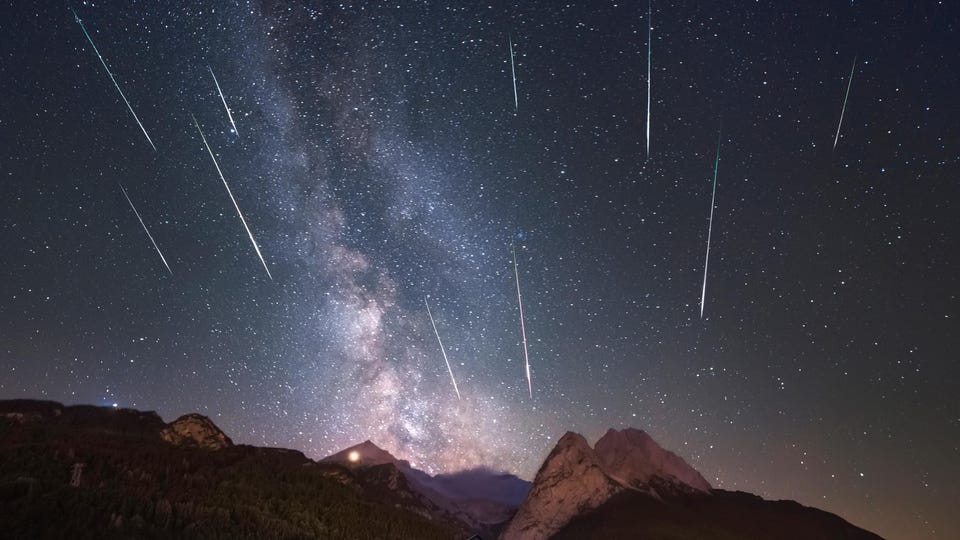Science Get Ready For ‘Shooting Star Saturday’ As Three Meteor Showers Combine Jamie Carter Senior Contributor Opinions expressed by Forbes Contributors are their own. I inspire people to go stargazing, watch the Moon, enjoy the night sky New! Follow this author to improve your content experience. Got it! Jul 26, 2022, 08:00pm EDT | New! Click on the conversation bubble to join the conversation Got it! Share to Facebook Share to Twitter Share to Linkedin 2018 Perseids meteor shower with the Milky way, taken in Garmisch-Partenkirchen in the Alps.
. . .
[+] Shooting stars are stacked according to their positions in the sky to show the (oppisite) radiant. Getty Are you ready for “shooting star Saturday?” This Saturday evening—close to midnight, and most likely through until the early hours of Sunday—sees the peak of the Delta Aquarids meteor shower. It comes at a time when reports of “fireballs” are increasing .
Surely it’s not as important as the famous Perseids meteor shower—summer’s display of “shooting stars” that peaks in August? There’s some bad news about that. The Perseids meteor shower is the year’s best for northern hemisphere stargazers because it combines warm weather with 100+ possible “shooting stars” per hour. The trouble is that this year’s peak night—August 12/13—coincides with a full Moon.
A full Moon is bright enough to bleach the night sky of stars—and definitely “shooting stars”—and to make things even worse it’s up all night long. So for this year it’s best to avoid the peak night of the Perseids meteor shower . Don’t go camping, don’t plan “shooting star” parties, don’t even bother going stargazing.
Just moongazing. Instead, be outside this Saturday night and in a dark place because you’ll not only likely see some early Perseids, but also the peak of the Delta Aquarids. You may also see something of the Alpha Capricornids meteor shower that will also be peaking.
MORE FOR YOU New Research Finds A Connection Between Domestic Violence And These Two Personality Disorders This Scientist Helps Andean Forests And Ecuador’s Women In STEM Exceptional Fossil Preservation Suggests That Discovering Dinosaur DNA May Not Be Impossible Here’s everything you need to know about the three meteor showers coming to a dark sky near you this weekend: What, when and where is the Delta Aquarids meteor shower? Dates: July 18 through August 21, 2022 Peak night: July 30/31, 2022 Radiant point: constellation of Aquarius About 10 to 20 “shooting stars” per hour are expected from the peak of the Delta-Aquarid meteor shower, which will occur in dark moonless skies (the waxing crescent Moon will be barely 3%-lit and will set just after the Sun). A dark sky will help you see them more easily, though the farther south you are the more meteors you’re likely to see. The Delta Aquarid meteor shower is caused by dust and debris being left in the inner Solar System by Comet 96P/Machholz.
CORFE CASTLE, UNITED KINGDOM – AUGUST 12: A Perseid Meteor flashes across the night sky above Corfe . . .
[+] Castle on August 12, 2016 in Corfe Castle, United Kingdom. The Perseids meteor shower occurs every year when the Earth passes through the cloud of debris left by Comet Swift-Tuttle, and appear to radiate from the constellation Perseus in the north eastern sky. (Photo by Dan Kitwood/Getty Images) Getty Images What, when and where is the alpha Capricornids meteor shower? Dates: July 7 through August 15, 2022 Peak night: July 30/31, 2022 Radiant point: constellation of Capricorn The alpha Capricornids are a minor meteor shower that delivers a few “shooting stars” per hour that move slowly.
Like the Delta Aquarids they’re going to appear to come from the southern sky as seen from the northern hemisphere. They’re caused by debris from comet 169P/NEAT. What, when and where is the Perseids meteor shower? Dates: July 7 through August 24, 2022 Peak night: August 12/13, 2022 Radiant point: constellation of Perseus The Perseid meteor shower is the year’s most popular display of “shooting stars.
” They’re caused by Comet Swift-Tuttle, which last passed through the solar system in 1992 on its 133-years long orbit of the Sun. Known for being both colorful and for having bright, persistent trails, Perseids can number as high as 100 per hour, though typically you can see about 50 per hour. Since you’ll be viewing them a good 10 nights before their peak you won’t see that many, but perhaps five or 10.
They’ll appear to shoot from the northwestern sky. When to see the three meteor showers combine OK, so it’s not going to be the very finest display of “shooting stars” the world has ever seen, but it’s the best we’ve got in 2022. Practically speaking we’re talking perhaps 10 per hour from the Delta Aqaurids and another 10 or so from the Perseids—which together makes it potentially pretty good! Thursday, July 28 sees a New Moon.
That makes July 29, 30 and 31’s night sky moonless after midnight, so if it’s clear on July 30/31 then you’ll be able to see the peak of the Delta Aquarids and some extra “shooting stars” from both the waxing Perseids and the alpha Capricornids. Good luck—and here’s a top tip: put your smartphone away! Wishing you clear skies and wide eyes. Follow me on Twitter or LinkedIn .
Check out my website or some of my other work here . Jamie Carter Editorial Standards Print Reprints & Permissions.
From: forbes
URL: https://www.forbes.com/sites/jamiecartereurope/2022/07/26/get-ready-for-shooting-star-saturday-as-three-meteor-showers-combine/
